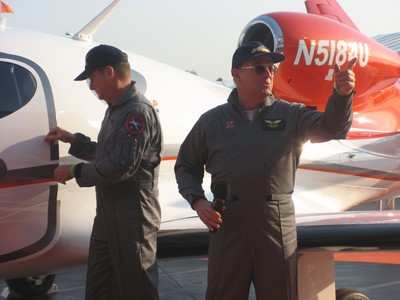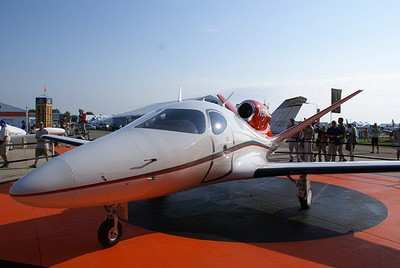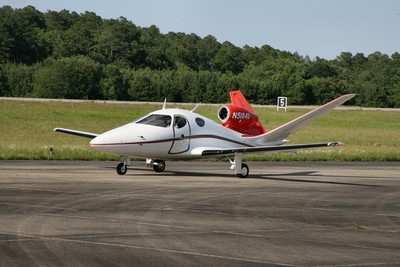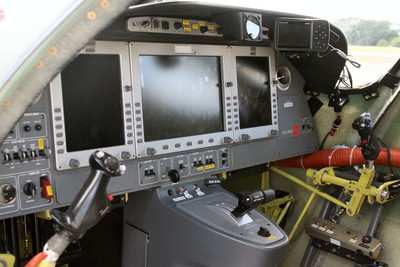Eclipse Surprises Attendees With ECJ Concept
Eclipse Aviation -- and company CEO Vern Raburn, in particular
-- certainly have a flair for the dramatic. At a kickoff press
event early Monday morning, before the gates opened at AirVenture
2007, the planemaker took the wraps off a concept model of its
Eclipse Concept Jet: a single engine, four-passenger, slightly
futuristic-in-appearance V-tailed aircraft intended to test the
waters in the emerging Personal Jet category.

But the planemaker didn't stop there. A line in Chief Operating
Officer Peg Billson's speech describing the concept model -- an
offhand remark about "flight testing" -- was drowned out by the
unmistakable (muted) scream of a single Pratt & Whitney Canada
PW610F turbofan, as the living and breathing ECJ made its
debut.
The crowd applauded as the tent flaps opened to reveal the
aircraft, with a grinning Raburn in the left seat (and company test
pilot Terry Tomeny in the co-pilot's chair.) As the engine spooled
down, Raburn emerged from the plane, and adopted his best "cool
test pilot" pose (shown below.)

Many in attendance were surprised by the appearance of the
aircraft (of course ANN was there during the aircraft's first
flight on July 2.) Raburn told ANN that was the intent
-- and, to show the aviation community Eclipse isn't standing
still.
"We kind of reject the notion that bigger is better," Raburn
said, on the ECJ's smallish proportions. "What you’re seeing
is an evolution of a marketplace. Think of this as a small sport
sedan, such as a BMW 3 Series."
The ECJ was flown into Oshkosh Sunday night, following a
six-month development schedule. Initial design kicked off in
mid-January of this year. To date, the unpressurized concept
aircraft has accumulated just under 30 flight hours, flying at
speeds up to 250 knots and altitudes up to 25,000 feet and
successfully demonstrated gear and flap operation since its very
first flight.

The ECJ has also conducted initial flutter testing, pre-stall
testing, engine restart, and other flight envelope expanding test
points. Raburn said only minor issues have cropped up during
testing, including somewhat harsh pitch reactions to variations in
throttle input.
Eclipse plans to use the ECJ program to analyze demand trends
within the growing single-engine jet marketplace, and gain customer
insight on potential future aircraft products and designs. The
initiative is modeled after the automobile industry's use of
concept cars, which showcase advanced styling and technology to
assess customer reactions to new car designs which may or may not
eventually be produced and gauge the potential market size.
Specifications
The ECJ is estimated to cruise at a top speed of 345 knots and
its service ceiling will be 41,000 feet. The aircraft's range is
estimated to be 1,250 nautical miles. A unique element of the ECJ's
aerodynamic design is its empennage, which features an external
mounted engine pod and V-Tail vertical surfaces that create what
Eclipse terms "exceptional" aerodynamic, weight, and operational
benefits.

The ECJ shares a number of design elements with the Eclipse 500.
Common to the ECJ and the Eclipse 500 are the wing assembly minus
the tip tanks, which includes the ailerons, the fuel system, main
landing gear and actuators, flaps and flap actuators, wheels and
brakes. The nose assembly is also common to both aircraft and
includes the nose landing gear assembly, landing gear doors,
forward pressure bulkhead, air conditioning and oxygen supply.
The ECJ also features Eclipse's all-electric Avio NG system,
controlling aircraft computer systems, flight control trims,
autopilot, electrical power distribution, FADEC, air data, AHRS,
landing gear and flap actuation. All of the ECJ's major system
components are controlled and managed using Avio NG, just as they
are on the Eclipse 500.
"When we first plugged in Avio NG into the panel [on the ECJ],
within 30 minutes it was powered on," Raburn noted.

The bench seat also has a vertical-tracking capability, allowing
for a large amount of flexible leg room. Both rear passenger seats
have access to 110V power plugs, cup holders and integrated MP3
player plugs for audio entertainment. Access into and out of the
cabin is provided through one left side door, allowing simple
entrance to flight deck and passenger seats.
External baggage is available in the tail of the ECJ, which has
the capacity to hold up to three full sets of golf clubs or
skis.
Partners
Raburn and Billson each stressed the relatively low cost in
developing the ECJ, due in part to sharing "about 60 percent"
component commonality with the twin-engine Eclipse 500. Additional
development cost savings were realized by partnering with Swift
Engineering of San Clemente, CA to assist with the design and
subsequently build the Eclipse Concept Jet (ECJ) in slightly over
six months.
"Swift Engineering has been a tremendous partner, and was
instrumental in taking this new aircraft from design to flight test
so rapidly," said Raburn. "We needed a proven aerodynamics expert
to aggressively drive this new initiative forward while we stayed
focused on our core business of ramping up Eclipse 500 production
and deliveries. Swift made it happen in record time."

Swift constructed the plane at a facility at Wallops Island
Flight Facility in Virginia -- also where initial flight testing
has taken place -- with the support of BaySys Technologies of
Onancock, VA and International Aero Engineering (IAE) of
Bellflower, CA. Swift Engineering contracted the companies to
support the aircraft build and the design of the interior cabin and
flight deck. With primary responsibility for aircraft assembly,
BaySys led a rapid build with care and precision; IAE, an expert in
interior and exterior finishing produced the full-scale interior
mockup, and painted both the mock-up and flight article.
 Aero-News: Quote of the Day (04.27.25)
Aero-News: Quote of the Day (04.27.25) ANN's Daily Aero-Linx (04.27.25)
ANN's Daily Aero-Linx (04.27.25) Classic Aero-TV: Veteran's Airlift Command -- Serving Those Who Served
Classic Aero-TV: Veteran's Airlift Command -- Serving Those Who Served Airborne-NextGen 04.22.25: NYC eVTOL Network, ForgeStar-1, Drone Safety Day
Airborne-NextGen 04.22.25: NYC eVTOL Network, ForgeStar-1, Drone Safety Day Airborne 04.21.25: Charter Bust, VeriJet Woes, Visual Approach Risks
Airborne 04.21.25: Charter Bust, VeriJet Woes, Visual Approach Risks







